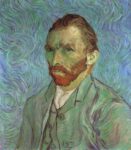
Vincent Van Gogh
Dutch, 1853–1890 (active France)
Roses, 1890
oil on canvas
27 15/16 × 35 7/16 in.
National Gallery of Art, Washington, Gift of Pamela Harriman in memory of W. Averell Harriman

Van Gogh,Self-Portrait, September 1889
”I’m working here with calm, unremitting ardor to give a last stroke of the brush. I’m working on a canvas of roses on bright green background and two canvases of large bouquets of violet Irises, one lot against a pink background in which the effect is harmonious and soft through the combination of greens, pinks, violets. On the contrary, the other violet bouquet (ranging up to pure carmine and Prussian blue) standing out against a striking lemon yellow background with other yellow tones in the vase and the base on which it rests is an effect of terribly disparate complementaries that reinforce each other by their opposition.”
– Letter to Theo, 11 May 1890
COMMENTS
Roses was painted shortly before Van Gogh's release from the asylum at Saint–Rémy. He felt he was coming to terms with his illness—and himself. In this healing process, painting was all–important. During those final three weeks of his recovery, he wrote his brother Theo, he had "worked as in a frenzy. Great bunches of flowers, violet irises, big bouquets of roses..."
This is one of two rose paintings Van Gogh made at that time. It is among his largest and most beautiful still lifes, with an exuberant bouquet in the glory of full bloom. Although he sometimes assigned certain meanings to flowers, Van Gogh did not make a specific association for roses. It is clear, though, that he saw all blossoming plants as celebrations of birth and renewal—as full of life. That sense is underscored here by the fresh spring green of the background. The undulating ribbons of paint, applied in diagonal strokes, animate the canvas and play off the furled forms of flowers and leaves. Originally, the roses were pink—the color has faded—and would have created a contrast of complementary colors with the green. Such combinations of complements fascinated Van Gogh. The paint is very thick—so thick that both rose paintings were left behind when Van Gogh left Saint–Rémy on May 16, 1890. As he explained to Theo, "these canvases will take a whole month to dry, but the attendant here will undertake to send them off after my departure." They arrived in Auvers by June 24.
- National Gallery of Art, 2021
https://www.nga.gov/collection/art-object-page.72328.html
SBMA CURATORIAL LABELS
Just before leaving the asylum of Saint-Rémy in May 1890, Van Gogh painted a glorious set of fl oral bouquets—two of irises and two of roses—of which this was the first. The newly flowering garden of the hospital furnished him with just the right subject to salute the arrival of spring as well as his imminent departure, first to Paris (to visit Theo and meet his new nephew, who was named after him) and then on to Auvers-sur-Oise. Little needs to be said about Van Gogh’s complete mastery of his medium when it comes to a painting like this one. Even Vincent had the conviction to report as much to Theo when the paintings shipped to Auvers: “Now the canvases from down there have arrived, the Irises have dried well and I dare believe that you’ll fi nd something in them; thus there are also some roses.”
Due to a chemical reaction, the red pigment that Van Gogh used in these fl ower paintings has altered over time, so that the complementary red and green scheme no longer has its force of contrast, and the roses appear to be only tinged with pink. We can imagine how the four canvases would have looked together, given the strong complementary colors still present in the bouquet with irises, now preserved at the J. Paul Getty Museum.
- Through Vincent's Eyes, 2022
